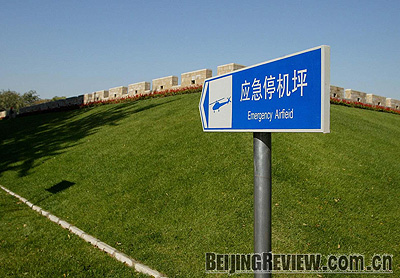|

SAFE LANDING: An emergency landing spot for helicopters in Yuan Dynasty Relics Park (ASIANEWSPHOTO)
Kublai Khan, the grandson of Genghis Khan, founded the Yuan Dynasty (1279-1368) and established the capital in Yanjing (the area of present day Beijing), which he named Dadu. Its city wall, a milestone in the urban construction history of China, was built, and Dadu became the last city constructed by an overall plan in Chinese feudal society.
In the early years of the Ming Dynasty (1368-1644), the northern part of the city wall was moved south some distance, leaving the north end of the city outside it. In 1957, it was listed as one of the key cultural relics protection units of Beijing. Today, the remains of the city wall are still an attraction, standing 10 meters tall in parts.
Yuan Dynasty Relics Park, based on the remains of the city wall, resembles a belt passing through both the Haidian and Chaoyang districts, 9 km in length and occupying 1.1 million square meters.
The park can withstand an earthquake up to a magnitude of 8.0 on the Richter scale. In 2003, Beijing's first emergency evacuation site was built in the park. It is also a base for education on what to do during an earthquake and other disasters. The design of the park draws on anti-quake knowledge from Japan and the United States.
As ordinary as it looks, the park is fixed with many "life lines" that could save lives in an emergency. Beneath the park's rockeries are water pipes and an emergency electricity network. The red circle marked in the middle of the monument wall is actually a parking area for emergency aircraft. On the ground, except for the public telephones, firefighting apparatuses, temporary toilets and material reserves, there are also empty rooms for use as an emergency commanding center, a sanitation and anti-epidemic station, and as shelter in an emergency.
Part of the park is situated on Beijing's north axis, together with the Olympic Park, and close to many Olympic venues, including the National Stadium. It integrates beautiful scenery, rich history and culture and hi-tech environmental protection. It is also an ecological park that uses non-polluting energy sources such as solar power.
The long park has many well-preserved historical scenic spots. The open air museum holds 19 statues of famous people from the Yuan Dynasty, including Kublai Khan, Marco Polo, one of the first Westerners to travel the Silk Road to China, as well as the renowned astronomer Guo Shoujing.
In the eastern end of the park, there is a wetland garden occupying 15,000 square meters built up in a triangle formed by the urban light rail and the city moat of the old wall.
In keeping with the park's innovative spirit, its network of paths was also designed using a new approach. Instead of laying the paths where they thought tourists might tread, the designers first laid grass and then put down paths where tourists could walk. | 